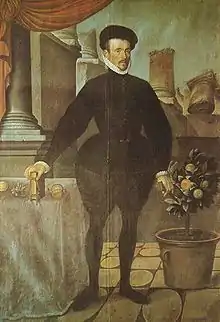Hans Bock (painter)
Hans Bock (1550, in Saverne – 16 March 1624, in Basel)[1] was a 16th Century German painter and draughtsman. He flourished at Basel where he executed several large frescoes, which won him much fame.[2] He is described as an "extraordinarily talented artist", the "symbol for his entire epoch" and the "leading painter and draftsman" in his period of German art.[3]

Bock is likely to have been working in Basel as early as 1570; in 1572 he paid for membership to the local guild of painters. He was awarded citizenship to Basel on the 18th of July, 1572.[3] He is likely to have educated the young Joseph Heintz in draughtsmanship.[4] From 1588 to 1591, he cooperated with the scholar Basilius Amerbach in the excavation of the Roman theater Augusta Raurica, providing illustrations of the newly excavated site.[5]
Bock had five children; Emanuel Bock the Elder, Felix Bock, Hans Bock the Younger, Niklaus Bock and Peter Bock.[1]
References
- "Bock, Hans (der Ältere)". SIKART.
- Bryan, Michael (1886). Dictionary of Painters and Engravers, Biographical and Critical, Volume 1: A-K. London: George Bell & Sons. pp. 142.
- Zeichnung/Drawings 2012 (PDF). August Laube. 2012. p. 46.
- Turner, Nicholas; Hendrix, Lee; Plazzotta, Carol (1997). European Drawings 3: Catalogue of the Collections (PDF). The J. Paul Getty Museum. p. 164.
- Schmitt, Lothar (2001). "Education and Learning among Sixteenth-Century German Artists". Studies in the History of Art. 60: 72–81. JSTOR 42622762.